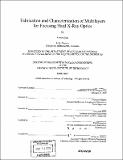Fabrication and characterization of multilayers for focusing hard x-ray optics
Author(s)
Ivan, Adrian, 1964-
DownloadFull printable version (10.97Mb)
Other Contributors
Massachusetts Institute of Technology. Dept. of Nuclear Engineering.
Advisor
Suzanne Romaine and Sow-Hsin Chen.
Terms of use
Metadata
Show full item recordAbstract
This study investigated the growth of multilayers with depth-graded thicknesses and their performance as x- ray mirrors for the next generation of focusing telescopes. Different material combinations were studied for the first time employing a consistent methodology for the DC magnetron sputtering growth of the multilayers and their characterization by x-ray reflectivity (XRR) measurements. The width of the interfaces was identified as the most important factor that must be controlled and minimized to achieve high reflectivity. The optimization of the process parameters led to interface widths ([sigma]) of 3.0-4.5 [angstroms] for both W/Si and Pt/C, the most interesting materials for this application. The other material combinations studied were: W/C, Mo/Si, Ni/C, Ni-V/C, WSi₂/Si, and Nb/Si. The interface widths for W/C were about 4 [angstroms], but wider ([sigma] [greater than or equal to] 7 [angstroms]) for Mo/Si and Ni/C. The analysis indicated that the large Mo/Si interface width was due to the formation of a silicide compound. In the case of Ni/C, TEM and XRR measurements concurred to an island growth mode of nickel for thicknesses less than 17 [angstroms], resulting in a high roughness at the C-on-Ni interface. A trial with WSi₂/Si multilayers showed values of sigma comparable to the simpler W/Si system. For Nb/Si the interface widths were larger than 9 [angstroms]. Depth graded W/Si, Pt/C, and W/C multilayers were deposited on flat substrates in process conditions optimized for low [sigma] (3-5 [angstroms]). Their x-ray reflectivity was measured at high energy using synchrotron radiation sources and confirmed the designs for the structure of the multilayers and the reflection bandpass. (cont.) The reflectivity was between 20 and 40 % for grazing incidence angles used in hard x-ray focusing telescopes. One of the deposition chambers built for this study has the unique capability to coat with multilayers the inside of integral conical shells that compose the telescope mirror system. We have accomplished for the first time this type of coatings and present results from their x-ray measurements.
Description
Thesis (Ph. D.)--Massachusetts Institute of Technology, Dept. of Nuclear Engineering, 2002. Includes bibliographical references.
Date issued
2002Department
Massachusetts Institute of Technology. Department of Nuclear Engineering; Massachusetts Institute of Technology. Department of Nuclear Science and EngineeringPublisher
Massachusetts Institute of Technology
Keywords
Nuclear Engineering.